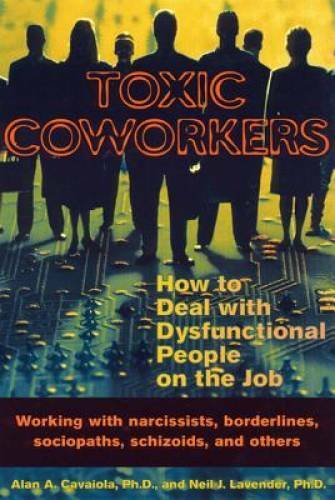
Item specifics
-
Condition
-
-
Brand
-
Unbranded
-
MPN
-
Does not apply
-
ISBN
-
9781572242197
-
Book Title
-
Toxic Coworkers : How to Deal with Dysfunctional People on the Job
-
Publisher
-
New Harbinger Publications
-
Item Length
-
8.9 in
-
Publication Year
-
2000
-
Format
-
Trade Paperback
-
Language
-
English
-
Item Height
-
0.5 in
-
Genre
-
Business & Economics, Psychology
-
Topic
-
General, Workplace Culture
-
Item Weight
-
10.6 Oz
-
Item Width
-
6.2 in
-
Number of Pages
-
216 Pages
Toxic Coworkers: How to Deal with Dysfunctional People on the Job – GOOD
About this product
Product Identifiers
Publisher
New Harbinger Publications
ISBN-10
1572242191
ISBN-13
9781572242197
eBay Product ID (ePID)
1675101
Product Key Features
Book Title
Toxic Coworkers : How to Deal with Dysfunctional People on the Job
Number of Pages
216 Pages
Language
English
Publication Year
2000
Topic
General, Workplace Culture
Genre
Business & Economics, Psychology
Format
Trade Paperback
Dimensions
Item Height
0.5 in
Item Weight
10.6 Oz
Item Length
8.9 in
Item Width
6.2 in
Additional Product Features
Intended Audience
Trade
LCCN
00-134870
Reviews
“Toxic Coworkers helps us make sense of work relationships that defy logic and consume our day. It is the perfect tool to help us understand and manage difficult people, the result of which is increased productivity and decreased frustration on the job.” – Heidi Remak, M.A., CEAP, Manager, EAP, Lucent Technologies, “Toxic Coworkers helps us make sense of work relationships that defy logic and consume our day. It is the perfect tool to help us understand and manage difficult people, the result of which is increased productivity and decreased frustration on the job.” Heidi Remak, M.A., CEAP, Manager, EAP, Lucent Technologies, “In the tradition of Robert Ringer’s Winning Through Intimidation and Wayne Dyer’s Your Erroneous Zones , Cavaiola and Lavender have made a big leap forward in showing how important psychological insights and principles can be readily applied to everyday problems in the workplace. From now on I’ll be handing frustrated employees, administrators, and executives a copy of Toxic Coworkers , an dI’ll feel confident that they will have a powerful tool for dealing with the dysfunctional people and warped behavior they encounter on the job.” -Dr. Robert J. Phillips, President, Corporate Extension Services, Providing Organizational Development, Team-building, Personnel Problem Resolutions, and Executive Coaching, “In the tradition of Robert Ringer’s Winning Through Intimidation and Wayne Dyer’s Your Erroneous Zones , Cavaiola and Lavender have made a big leap forward in showing how important psychological insights and principles can be readily applied to everyday problems in the workplace. From now on I’ll be handing frustrated employees, administrators, and executives a copy of Toxic Coworkers , an dI’ll feel confident that they will have a powerful tool for dealing with the dysfunctional people and warped behavior they encounter on the job.” –Dr. Robert J. Phillips, President, Corporate Extension Services, Providing Organizational Development, Team-building, Personnel Problem Resolutions, and Executive Coaching, “In the tradition of Robert Ringer’s Winning Through Intimidation and Wayne Dyer’s Your Erroneous Zones, Cavaiola and Lavender have made a big leap forward in showing how important psychological insights and principles can be readily applied to everyday problems in the workplace. From now on I’ll be handing frustrated employees, administrators, and executives a copy of Toxic Coworkers, an dI’ll feel confident that they will have a powerful tool for dealing with the dysfunctional people and warped behavior they encounter on the job.” –Dr. Robert J. Phillips, President, Corporate Extension Services, Providing Organizational Development, Team-building, Personnel Problem Resolutions, and Executive Coaching
Synopsis
The subject of this book-an Italian-born exiled Prince-has become an icon of misjudged romanticism and Scottish nationalism; much of this is due to the way he has been portrayed over the years. This study traces how the enduring visual image of Prince Charles Edward Stuart was created, beginning with his birth in 1720 and ending with the exhibition of John Pettie’s Prince Charles Edward Stuart Entering the Ballroom at Holyrood – probably still the most enduring and popular image of the Stuart prince-at the Royal Academy in 1892. This book considers the role of portraiture in the Stuart court, both before and after exile in 1688 and how the well-established traditions of royal portraiture and image-making were used by the Stuart dynasty to promote their ambitions and stature. Charles’s birth in 1720 resulted in a flurry of portrait commissions in which he was depicted as the royal heir apparent. The messianic role with which he was invested reached its apotheosis with the Jacobite uprising of 1745. He adopted the costume and manners of an idealized Highland chieftain and within the space of a few months created an abiding iconography which was to endure long after his death. The major portraits of Charles executed during his lifetime are considered, from the early court portraits of Antonio David and Domenico Dupra to the final images of a broken man by Ozias Humphrey and Hugh Douglas Hamilton. Alongside this, there is a thorough examination of a parallel phenomenon in which works of art, observing established parameters, were copied and adapted, and then re-copied, until the tartan-clad ideal of 1745 began to eclipse the real person. The revering of Charles Edward and the manufacture of items bearing his likeness are compared to other “cults” of the individual and contrasted with the “commercialization of politics” which several commentators have identified as a coherent phenomenon of late eighteenth-century British life. The extent to which the material culture that surrounded the persona of Char, This juicy read is the first book that shows readers how to identify and effectively deal with a coworker who has a full-fledged personality disorder., We’ve all worked with someone “difficult,” someone who could always be trusted to blow up to space out or do or say something wildly inappropriate. As it happens, those of us who concluded “the guy’s just nuts” were right: a fair number of those impossible-to-get-along-with employees actually do have full-fledged personality disorders. In Toxic Coworkers, the authors help us to recognize a variety of common personality traits and disorders, understand how they come about, and learn to develop effective strategies for dealing with them. So the next time the narcissist who runs the front desk is bugging you, or you need to squeeze a favor out of the schizoid who handles inventory, you’ll know exactly what to do.
LC Classification Number
HF5549.5.E42C38 2000
Price : 4.74
Ends on : N/A
View on eBay



